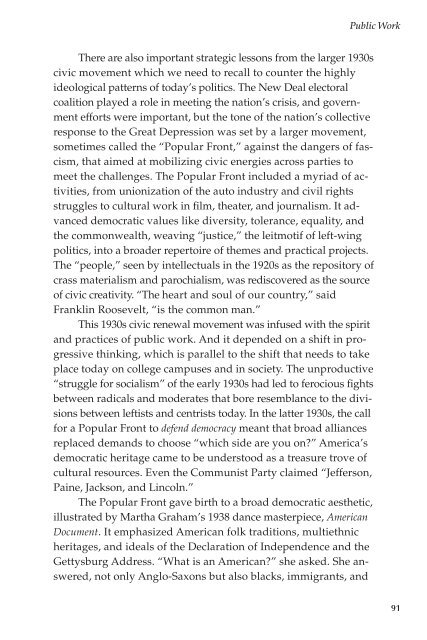Agent of Democracy - Society for College and University Planning
Agent of Democracy - Society for College and University Planning
Agent of Democracy - Society for College and University Planning
Create successful ePaper yourself
Turn your PDF publications into a flip-book with our unique Google optimized e-Paper software.
Public Work<br />
There are also important strategic lessons from the larger 1930s<br />
civic movement which we need to recall to counter the highly<br />
ideological patterns <strong>of</strong> today’s politics. The New Deal electoral<br />
coalition played a role in meeting the nation’s crisis, <strong>and</strong> government<br />
ef<strong>for</strong>ts were important, but the tone <strong>of</strong> the nation’s collective<br />
response to the Great Depression was set by a larger movement,<br />
sometimes called the “Popular Front,” against the dangers <strong>of</strong> fascism,<br />
that aimed at mobilizing civic energies across parties to<br />
meet the challenges. The Popular Front included a myriad <strong>of</strong> activities,<br />
from unionization <strong>of</strong> the auto industry <strong>and</strong> civil rights<br />
struggles to cultural work in film, theater, <strong>and</strong> journalism. It advanced<br />
democratic values like diversity, tolerance, equality, <strong>and</strong><br />
the commonwealth, weaving “justice,” the leitmotif <strong>of</strong> left-wing<br />
politics, into a broader repertoire <strong>of</strong> themes <strong>and</strong> practical projects.<br />
The “people,” seen by intellectuals in the 1920s as the repository <strong>of</strong><br />
crass materialism <strong>and</strong> parochialism, was rediscovered as the source<br />
<strong>of</strong> civic creativity. “The heart <strong>and</strong> soul <strong>of</strong> our country,” said<br />
Franklin Roosevelt, “is the common man.”<br />
This 1930s civic renewal movement was infused with the spirit<br />
<strong>and</strong> practices <strong>of</strong> public work. And it depended on a shift in progressive<br />
thinking, which is parallel to the shift that needs to take<br />
place today on college campuses <strong>and</strong> in society. The unproductive<br />
“struggle <strong>for</strong> socialism” <strong>of</strong> the early 1930s had led to ferocious fights<br />
between radicals <strong>and</strong> moderates that bore resemblance to the divisions<br />
between leftists <strong>and</strong> centrists today. In the latter 1930s, the call<br />
<strong>for</strong> a Popular Front to defend democracy meant that broad alliances<br />
replaced dem<strong>and</strong>s to choose “which side are you on?” America’s<br />
democratic heritage came to be understood as a treasure trove <strong>of</strong><br />
cultural resources. Even the Communist Party claimed “Jefferson,<br />
Paine, Jackson, <strong>and</strong> Lincoln.”<br />
The Popular Front gave birth to a broad democratic aesthetic,<br />
illustrated by Martha Graham’s 1938 dance masterpiece, American<br />
Document. It emphasized American folk traditions, multiethnic<br />
heritages, <strong>and</strong> ideals <strong>of</strong> the Declaration <strong>of</strong> Independence <strong>and</strong> the<br />
Gettysburg Address. “What is an American?” she asked. She answered,<br />
not only Anglo-Saxons but also blacks, immigrants, <strong>and</strong><br />
91

















